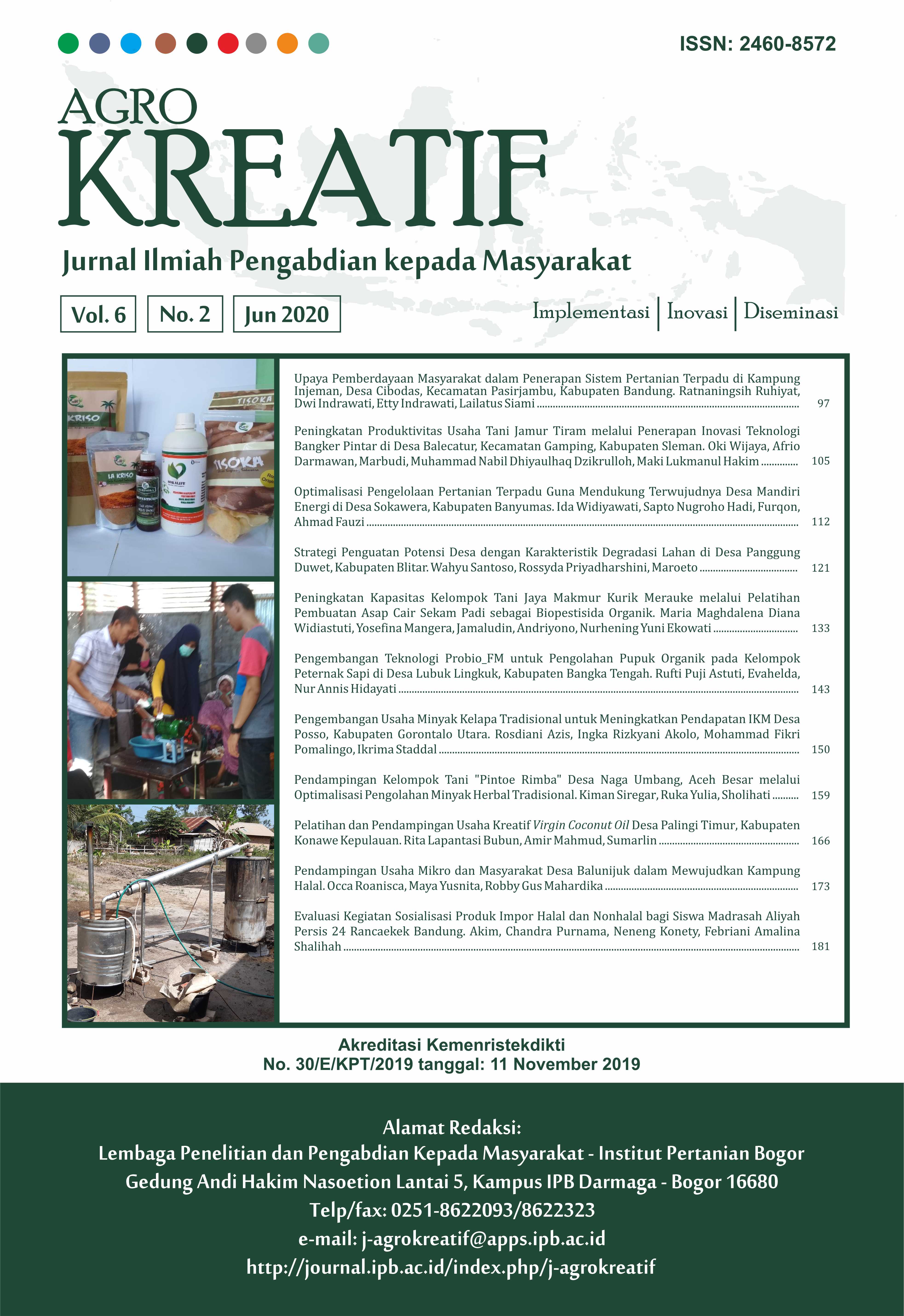Peningkatan Kapasitas Kelompok Tani Jaya Makmur Kurik Merauke melalui Pelatihan Pembuatan Asap Cair Sekam Padi sebagai Biopestisida Organik
Abstract
Farmers ussually using chemical pesticides and mostly ignore the recommended dosage, chemical pesticides used spend 20% of analysis farming bussiness and food saftey become neglected for increasing production. The purpose of community capacity building is to increase farmers knowledge of making liquid smoke from agricultural waste rice husk as biopesticides for farmer groups in Kampung Jaya Makmur, Merauke Regency. The method of this empowerment by training and mentoring the process of liquid smoke production and assist the process of marketing liquid smoke products. The results of community service were the modifications of kiln drum (biochar maker) belong to farmer group into a liquid smoke maker using the pyrolysis method. This tool has been trial process and trained to farmers group of Jaya Makmur. The training of process of liquid smoke was attended by 26 farmers, 2 pioneer farmers, 3 students, and 9 lecturers from the Faculty of Agriculture and the Faculty of Engineering Musamus University. The capacity building was followed by assisting program for biochar and liquid smoke production and calculating operational costs of liquid smoke production, product packaging, and opportunities for selling liquid smoke as biopesticides organic among the farmers. Recent conclusion of this community capacity building has been increasing knowledge among farmers from 20.3% to 57%. Through the assistance, the group of production biochar center was empowered become center of input agricultural such as biopestisida and biochar.
Downloads
References
Aliyanto. 2013. Perancangan Alat Pirolisis Asap Cair dari Sekam Padi Kapasitas 50 kg per proses.[Thesisi]. Malang (ID): Universitas Muhamadiyah Malang.
[BPS] Badan Pusat Statistik Kabupaten Merauke. 2017. Merauke Dalam Angka 2016. Merauke (ID): Badan Pusat Statistik Kabupaten Merauke.
Hagner M. (2013). Potential of the slow pyrolisis products birch tar oil, wood vinegar and biochar in sustainable plant protection-pesticidal effects, soil improvement risks. Finland (FI): Departement of Enviromental of Helsinki, Lahti.
Isa I, Musa WJ, Rahman SW. 2019. Pemanfaatan asap cair tempurung kelapa sebagai pestisida organik terhadap mortalitas ulat grayak (Spodoptera litura F.). Jambura Journal of Chemistry. 01(1): 15‒20. https://doi.org/ 10.34312/jambchem. v1i1.2102
Jaya DJ, Zulmi A, Wahyudi D, Kartika WH, Yuliana N, Kholis N. 2015. Optimasi pembuatan asap cair dari sekam padi dan aplikasinya sebagai pupuk tanaman hidroponik. Jurnal Teknologi Agro-Industri. 2(2): 28‒32. https://doi.org/ 10.34128/jtai.v2i2.17
Komarayati S, Gusmailina, Gustan P. 2014. Pengaruh arang dan cuka kayu terhadap peningkatan pertumbuhan dan simpanan karbon. Jurnal Penelitian Hasil Hutan. 32(4): 313‒328. https://doi.org/10.20886/jphh. 2014.32.4.313-328
Novita S. 2011. Kinerja dan analisis tekno-ekonomi alat penghasil asap cair dengan bahan baku limbah pertanian. Padang (ID): Universitas Andalas.
Nugrahaini D, Laila KE, Tarwotjo U, Prianto AH. 2017. Identifikasi kandungan senyawa kimia cuka kayu dari sekam padi. Jurnal BIOMA. 19(1): 30‒37. https://doi.org/10.14710/ bioma.19.1.30-37
Pertiwi SD, Khoiriyah R. 2016. Kontan. [Internet]. [Diakses pada: ]. Tersedia pada: http://kontan.co.id.
Putri ER, Mislaini, Ningsih SL. 2015. Pengembangan alat penghasil asap cair dari sekam padi untuk menghasilkan insektisida organik. Jurnal Teknologi Pertanian Andalas. 19(2): 29‒36.
Sinar Tani. 2010. Cuka kayu penyubur dan penguat tanaman. Jakarta (ID): Sinar Tani.
Widiastuti MM. 2018. Economic Impact of Pesticides and Biosecurity Agriculture Development in Merauke Border Area of RI-PNG. Bali (ID): Masterclass Biosecurity. https://doi.org/10.31227/osf.io/vcnp7
Widiastuti MM, Lantang B. 2017. Pelatihan pembuatan biochar dari limbah sekam padi menggunakan metode retort kiln. Agrokreatif Jurnal Ilmiah Pengabdian kepada Masyarakat. 3(2): 129‒135. https://doi.org/10.29244/ agrokreatif.3.2.129-135
Yatagai. 2002. Utilization of charcoal and wood vinegar in Japan. Jepang (JP): The University of Tokyo.
This work is licensed under a Creative Commons Attribution-NonCommercial 4.0 International License.



















